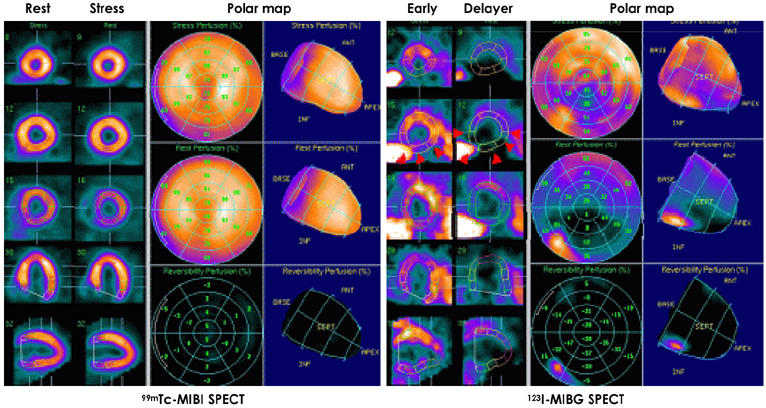Korean Circ J.
2007 Oct;37(10):510-516. 10.4070/kcj.2007.37.10.510.
The Significance of Cardiac Sympathetic Nerve Imaging with 123I-Metaiodobenzylguanidine for Predicting the Occurrence of Ventricular Tachycardia in Patients with Idiopathic Dilated Cardiomyopathy
- Affiliations
-
- 1Division of Cardiology, Department of Internal Medicine, Yeungnam University Hospital, Daegu, Korea. dgshin@med.yu.ac.kr
- 2Department of Nuclear Medicine, Yeungnam University Hospital, Daegu, Korea.
- KMID: 2227053
- DOI: http://doi.org/10.4070/kcj.2007.37.10.510
Abstract
-
BACKGROUND AND OBJECTIVE: Ventricular arrhythmia is an important cause of death in patients suffering with idiopathic dilated cardiomyopathy (IDCM). The decreased uptake or increased "washout" of 123I-metaiodobenzylguanidine (MIBG)-derived radioactivity is associated with a worse prognosis or severe disease in patients with cardiac diseases.
SUBJECTS AND METHODS
Forty patients (28 men, mean age: 56.5+/-13.0 years) with angiographically proven IDCM were studied and divided into 2 groups: the patients with clinically documented ventricular tachycardia (VT) and IDCM (group A; 17 patients), and the patients without VT, but with IDCM (group B; 23 patients). The normal control group (7 men, mean age 62.4+/-7.9) was compared theses patients. 123I-MIBG was evaluated by the early (15 min) and delayed (3hours) uptake, the heart to mediastinum uptake (H/M) ratio and the global and regional washout ratio (WOR) that was defined as the [early H uptake-delayed H uptake]/early H uptake. The clinical variables, echocardiographic parameters and 123I-MIBG-derived parameters were compared among three groups.
RESULTS
There were no significant differences in age and the echocardiographic parameters between the groups A and B. A significant negative correlation was present between the early inferior wall H/M ratio and the LVEDD (Spearman's correlation, r=-0.412, p=0.08), and the early inferior H/M ratio and the LVESD (Spearman's correlation, r=-0.463, p=0.03). Only the delayed lateral wall uptake was significantly lower in group A than that in group B (23.3+/-5.3 versus 27.8+/-8.4, respectively p=0.042). The regional WOR was not statically different among the three groups.
CONCLUSION
Cardiac 123I-MIBG SPECT partially reflects the vulnerability for the occurrence of VT in patients suffering with IDCM. These results support the feasibility of using cardiac 123I-MIBG SPECT as a prognostic tool in IDCM patients.
MeSH Terms
Figure
Reference
-
1. Higuchi T, Schwaiger M. Imaging cardiac neuronal function and dysfunction. Curr Cardiol Rep. 2006. 8:131–138.2. Knuuti J, Sipola P. Is it time for cardiac innervation imaging? Q J Nucl Med Mol Imaging. 2005. 49:97–105.3. Kang DY. Clinical application of I-123 MIBG cardiac imaging. Korean J Nucl Med. 2004. 38:331–337.4. Ha JW, Lee JD, Chung N, et al. Iodine-123-metaiodobenzylguanidine myocardial scintigraphy in patient with dilated cardiomyopathy: correlation between myocardial MIBG uptake and echocardiographic parameter. Korean Circ J. 1996. 26:651–666.5. Ha JW, Lee JD, Jang Y, et al. Assessment of cardiac sympathetic neuronal integrity using Iodine-123 metaiodobenzylguanidine myocardial scintigraphy and its clinical efficacy as a new noninvasive screening test for the diagnosis of coronary artery spasm. Korean Circ J. 1998. 28:183–193.6. Wakabayashi T, Nakata T, Hashimoto A, et al. Assessment of underlying etiology and cardiac sympathetic innervation to identify patients at high risk of cardiac death. J Nucl Med. 2001. 42:1757–1767.7. Imamura Y, Fukuyama T. Prognostic value of myocardial MIBG scintigraphy findings in patients with cardiomyopathy: importance of background correction for quantification of MIBG activity. Ann Nucl Med. 2002. 16:387–393.8. Gill JS, Hunter GJ, Gane J, Ward DE, Camm AJ. Asymmetry of cardiac 123I- meta-iodobenzyl-guanidine scans in patients with ventricular tachycardia and a "clinically normal" heart. Br Heart J. 1993. 69:6–13.9. Mitrani RD, Klein LS, Miles WM, et al. Regional cardiac sympathetic denervation in patients with ventricular tachycardia in the absence of coronary artery disease. J Am Coll Cardiol. 1993. 22:1344–1353.10. Yoshioka K, Gao DW, Chin M, et al. Heterogeneous sympathetic innervation influences local myocardial repolarization in normally perfused rabbit hearts. Circulation. 2000. 101:1060–1066.11. Ferrans VJ, Hibbs RG, Walsh JJ, Burch GE. Histochemical and electron microscopical studies on the cardiac necroses produced by sympathomimetic agents. Ann N Y Acad Sci. 1969. 156:309–332.12. Kim SJ, Lee DY, Lee JD, et al. Evaluation of sympathetic innervation in cardiomyopathy with 123I-MIBG. Korean J Nucl Med. 1993. 27:195–202.13. Gao DW, Talke PO, Dae MW. Effects of reduced sympathetic activity on myocardial metaiodobenzylguanidine (MIBG) washout. J Auton Pharmacol. 2001. 21:159–164.14. Dae MW, O'Connell JW, Botvinick EH, et al. Scintigraphic assessment of regional cardiac adrenergic innervation. Circulation. 1989. 79:634–644.15. Turpeinen A, Vanninen E, Magga J, Tuomainen P, Kuusisto J, Sipola P. Cardiac sympathetic activity is associated with elevated levels of proinflammatory cytokines in patients with idiopathic dilated cardiomyopathy. Eur J Nucl Med. 2004. 31:S292.16. Kyuma M, Nakata T, Hashimoto A, et al. Incremental prognostic implications of brain natriuretic peptide, cardiac sympathetic nerve innervation, and noncardiac disorders in patients with heart failure. J Nucl Med. 2004. 45:155–163.17. Maeno M, Ishida Y, Shimonagata T, et al. The significance of 201Tl/123I MIBG (metaiodobenzylguanidine) mismatched myocardial regions for predicting ventricular tachycardia in patients with idiopathic dilated cardiomyopathy. Kaku Igaku. 1993. 30:1221–1229.18. Henderson EB, Kahn JK, Corbett JR, et al. Abnormal I-123 metaiodobenzylguanidine myocardial washout and distribution may reflect myocardial adrenergic derangement in patients with congestive cardiomyopathy. Circulation. 1988. 78:1192–1199.
- Full Text Links
- Actions
-
Cited
- CITED
-
- Close
- Share
- Similar articles
-
- Hemodynamics and Left Ventricular Cineangiographic Findings in Idiopathic Dilated Cardiomyopathy
- Clinical Application of I-123 MIBG Cardiac Imaging
- Cardiac Resynchronization Therapy Defibrillator Treatment in a Child with Heart Failure and Ventricular Arrhythmia
- Mid-Ventricular Hypertrophic Obstructive Cardiomyopathy Complicated by an Apical Aneurysm, Presenting as Ventricular Tachycardia
- Iodine-123-Metaiodobenzylguanidine Myocardial Scintigraphy in Patients with Dilated Cardiomyopathy : Correlation between Myocardial MIBG Uptake and Echocardiographic Parameters




